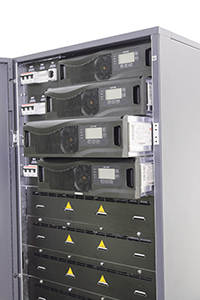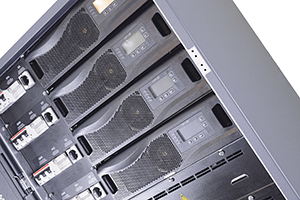What is your definition of a Modular UPS?
The operational benefits of modular uninterruptible power supplies are well known and the terminology associated with modular UPS systems such as flexibility, availability, scalability, right-sizing, pay-as-you-grow and safe swap, etc, are widely used but the term ‘modular UPS’ itself can mean different things to different people.
 It is important, therefore, to carefully check the nature of what is being described as a ‘modular UPS system’ to ensure you are getting what you pay for and the critical load in your data centre, server room or hospital is protected at all times.
It is important, therefore, to carefully check the nature of what is being described as a ‘modular UPS system’ to ensure you are getting what you pay for and the critical load in your data centre, server room or hospital is protected at all times.
Parallel UPS
A single standalone UPS unit that protects a critical load is known as an N system configuration. While such a single UPS is suitable for some applications it lacks any resilience in the event that the UPS unit develops a fault or is offline for preventative maintenance.
The resilience of a single standalone UPS can be increased by connecting a second standalone UPS unit of the same power rating in parallel to the single standalone UPS. This is called a parallel redundant UPS because it adds redundancy to the UPS system and is also known as an N+1 UPS system.
Several standalone units can be paralleled together to increase the power rating of the UPS system. This is paralleling for capacity and is still an N system.
An extreme example of paralleling for capacity and redundancy is connecting 101 off 1KVA UPS units in parallel which would provide a 100KVA N+1 configuration. Such a 101 module system would not be practical but it demonstrates the concept.
At its simplest level then, a modular UPS system can be described as any number of discrete UPS connected together to create a larger and/or more resilient UPS system. But this does not tell the whole story.
Components or sub-assemblies as modules
Another definition of a ‘modular UPS system’ is a standalone UPS designed and manufactured in a modular format where the UPS’s main component parts of rectifier, inverter and static switch are modular sub-assemblies. In this case, if there is a problem with one of the sub-assemblies it can easily be replaced, however, when this one sub-assembly fails the whole UPS functionality fails and it, hopefully, will switch via its static switch to the raw mains.
It may be described as a modular uninterruptible power supply but, again, it does not tell the whole story.
 True modular
True modular
Some modular UPS systems have the rectifier and inverter within their modules but the system’s static switch is centralised and in a separate module. This configuration is known as centralised parallel architecture (CPA) and the static switch is a single point of failure. CPA systems provides a lower level of critical power protection and, in almost all professional UPS applications, should not be used.
A true modular UPS is a UPS system where several discrete UPS modules are paralleled together within a frame. All the individual UPS modules are fully functioning UPSs in their own right and are capable of operating on their own as a single UPS. Each UPS module contains it own rectifier, inverter, static switch and logic so no single UPS module is dependent upon the operation of another module to operate. This is known as decentralised parallel architecture (DPA) and this, and its later incarnations such as decentralised active-redundant parallel architecture (DARA), should be used.
An example of a true modular UPS is 3 off 50kW UPS modules contained within a 5 module frame to give either 150kW capacity or 100kW N+1 (parallel redundant). If the critical load increases, another 50kW UPS module can be very quickly and easily added to the frame, without the need for any additional electrical installation works, to give 200kW capacity or 150kW N+1. This is known as ‘scalability’ and is a feature of a true modular UPS.
If a UPS module fails it will need to be replaced. A true modular UPS will have ‘safe swap’ (also known as ‘hot swap’) modules that can quickly and safely, for both the operator and the critical load, be swapped. Centiel’s CumulusPower is the market leading true modular UPS and has safe swap modules that can be swapped out in less than 3 minutes, giving an availability of ‘9 nines’ (99.9999999%).
 Conclusion
Conclusion
The purpose of a UPS system is to provide clean uninterruptible power to its critical load 100% of the time. This means that there must be no single points of failure and the UPS system must be capable of being maintained and repaired without disruption to the critical load. Additionally, if the critical load should ever increase the UPSs capacity must also be able to increase.
True modular three phase UPS is the fastest growing sector of the UPS market. This is because they combine the key benefits of very high availability, scalability and maintainability better than any other UPS topology. However, not all modular UPS are true modular UPS so it is important to check the configuration and the definition of a modular system carefully before purchasing it. Selecting the wrong UPS can be an expensive mistake.
CENTIEL’s design team has been working with critical power protection for many years at the forefront of technological development. They are the trusted advisors to some of the world’s leading institutions and its modular UPS product range only contains true modular UPS. Its CumulusPower™ three phase modular UPS offers the industry-leading availability of 99.9999999% (9 nines), provides the lowest total cost of ownership (TCO) because of its very high level of operating efficiency and low maintenance costs and is available in a single cabinet of 900kW capacity.
For more information about this and Centiel’s full range of UPS solutions, please see: www.centiel.co.uk

